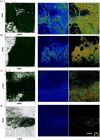Factors associated with obesity alter matrix remodeling in breast cancer tissues
- PMID: 31983145
- PMCID: PMC6982464
- DOI: 10.1117/1.JBO.25.1.014513
Factors associated with obesity alter matrix remodeling in breast cancer tissues
Abstract
Obesity is associated with a higher risk of developing breast cancer and with worse disease outcomes for women of all ages. The composition, density, and organization of the breast tissue stroma are also known to play an important role in the development and progression of the disease. However, the connections between obesity and stromal remodeling are not well understood. We sought to characterize detailed organization features of the collagen matrix within healthy and cancerous breast tissues acquired from mice exposed to either a normal or high fat (obesity inducing) diet. We performed second-harmonic generation and spectral two-photon excited fluorescence imaging, and we extracted the level of collagen-associated fluorescence (CAF) along with metrics of collagen content, three-dimensional, and two-dimensional organization. There were significant differences in the CAF intensity and overall collagen organization between normal and tumor tissues; however, obesity-enhanced changes in these metrics, especially when three-dimensional organization metrics were considered. Thus, our studies indicate that obesity impacts significantly collagen organization and structure and the related pathways of communication may be important future therapeutic targets.
Keywords: breast cancer; collagen fiber organization; gray-level co-occurrence matrix; obesity; second-harmonic generation; three-dimensional variance; two-photon excitation fluorescence.
Figures




Similar articles
-
Collagen reorganization at the tumor-stromal interface facilitates local invasion.BMC Med. 2006 Dec 26;4(1):38. doi: 10.1186/1741-7015-4-38. BMC Med. 2006. PMID: 17190588 Free PMC article.
-
Three dimensional multiphoton imaging of fresh and whole mount developing mouse mammary glands.BMC Cancer. 2013 Aug 6;13:373. doi: 10.1186/1471-2407-13-373. BMC Cancer. 2013. PMID: 23919456 Free PMC article.
-
Stromal PTEN Regulates Extracellular Matrix Organization in the Mammary Gland.Neoplasia. 2019 Jan;21(1):132-145. doi: 10.1016/j.neo.2018.10.010. Epub 2018 Dec 12. Neoplasia. 2019. PMID: 30550871 Free PMC article.
-
Minimally invasive multiphoton and harmonic generation imaging of extracellular matrix structures in lung airway and related diseases.Pulm Pharmacol Ther. 2011 Oct;24(5):487-96. doi: 10.1016/j.pupt.2011.03.008. Epub 2011 Apr 7. Pulm Pharmacol Ther. 2011. PMID: 21497667 Review.
-
A mouse mammary gland involution mRNA signature identifies biological pathways potentially associated with breast cancer metastasis.J Mammary Gland Biol Neoplasia. 2009 Jun;14(2):99-116. doi: 10.1007/s10911-009-9120-1. Epub 2009 Apr 30. J Mammary Gland Biol Neoplasia. 2009. PMID: 19408105 Review.
Cited by
-
Obesity and Fibrosis: Setting the Stage for Breast Cancer.Cancers (Basel). 2023 May 26;15(11):2929. doi: 10.3390/cancers15112929. Cancers (Basel). 2023. PMID: 37296891 Free PMC article. Review.
-
Breast cancer microenvironment and obesity: challenges for therapy.Cancer Metastasis Rev. 2022 Sep;41(3):627-647. doi: 10.1007/s10555-022-10031-9. Epub 2022 Apr 18. Cancer Metastasis Rev. 2022. PMID: 35435599 Free PMC article. Review.
-
Synergistic label-free fluorescence imaging and miRNA studies reveal dynamic human neuron-glial metabolic interactions following injury.Sci Adv. 2024 Dec 13;10(50):eadp1980. doi: 10.1126/sciadv.adp1980. Epub 2024 Dec 11. Sci Adv. 2024. PMID: 39661671 Free PMC article.
References
-
- Northey J. J., Przybyla L., Weaver V. M., “Tissue force programs cell fate and tumor aggression,” Cancer Discovery 7(11), 1224–1237 (2017).10.1158/2159-8290.CD-16-0733 - DOI - PMC - PubMed
Publication types
MeSH terms
Substances
Grants and funding
LinkOut - more resources
Full Text Sources
Medical

